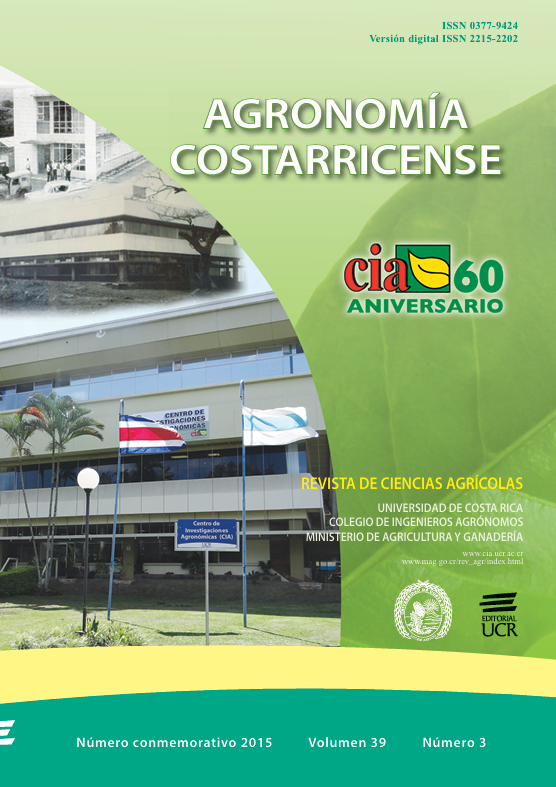Abstract
Quality characteristics and yield components were evaluated in an F1 progeny of 837 hybrids from a cross between potato genotypes selected for their characteristics of resistance, tuber yield and tuber quality. Sexual seed were grown under greenhouse conditions and tuber characteristics as skin and pulp color, eye depth, tuber number and total weight pert plant were assessed for each hybrid at harvest time. Thereafter, the hybrids were planted in the field through 3 clonal generations. In each cycle a selection based on resistance to late blight (Phytophthora infestans (Mont.) de Bary) and leafminer (Liriomyza huidobrensis Blanchard) was performed and those hybrids with undesirable characteristics in the tubers were also discarded. At harvest of the third clonal generation in the field, yield components and tuber quality of each hybrid were also recorded. As a result, 19 hybrids were selected at the end of the 3 cycles of field evaluation. Most of these hybrids show cream-colored flesh, oval shape, smooth skin and shallow eyes. Additionally, the hybrids yielded an average of one kilogram per plant, plus high contents of starch and total solids.References
ALMEKINDERS C.J. 1991. Flowering and true seed production in potato (Solanum tuberosum). Potato Research 34(4):379-388.
ALMEKINDERS C.J., STRUIK P.C. 1996. Shoot development and flowering in potato (Solanum tuberosum). Potato Research 39(4):581-607.
ARCE F.A. 2002. El Cultivo de la patata. 2 ed. Madrid, ES, Ediciones Mundi-Prensa. 495 p.
BACH S. 2011. Genotype by environment interaction effects on starch, fibre and agronomic traits in potato. Mag. Sc. thesis, Ontario, CA, University of Guelph. 208 p.
BRADSHAW J.E., MACKAY G.R. 1994. Potato genetics. Wallingford, UK, CAB International. 512 p.
CALIGARI P.D., BROWN J., ABBOTT R.J. 1986. Selection for yield and yield components in the early generations of a potato breeding programme. Theor. Appl. Genet. 73:218-222.
CAPEZIO S., HUARTE M., CARROZZI L. 1993. Selección por peso específico en generaciones tempranas en el mejoramiento de la papa. Revista Latinoamericana de la Papa 5/6(1):54-63.
CIP (CENTRO INTERNACIONAL DE LA PAPA). 2007. Procedures for standard evaluation trials of advanced potato clones. Lima, PE, Centro Internacional de la Papa. 124 p.
DE SOUZA E., PEREIRA C.A. 2002. Agronomic performance of potato interspecific hybrids. Crop Breeding and Applied Biotechnology 2(2):179-188.
DE SOUZA E., PEREIRA C.A., SIMON G.A. 2005. Sequential selection of potato clones. Crop Breeding and Applied Biotechnology 5:149-156.
ESTRADA N. 2000. La biodiversidad en el mejoramiento genético de la papa. La Paz, BO, Centro de Información para el Desarrollo. 372 p.
FAO (FOOD AND AGRICULTURE ORGANIZATION). 2008. Las papas, la nutrición y la alimentación. Roma, IT, FAO. 2 p.
GABRIEL J.L., CARRASCO E., GARCÍA W., EQUISE H., NAVIA O., TORREZ R., ORTUÑO N., FRANCO J., THIELE G., ESTRADA N. 2001. Experiencias y logros sobre mejoramiento convencional y selección participativa de cultivares de papa en Bolivia. Revista Latinoamericana de la Papa 12(1):169-192.
HASBÚN J., ESQUIVEL P., BRENES A., ALFARO I. 2009. Propiedades físico-químicas y parámetros de calidad para uso industrial de cuatro variedades de papa. Agronomía Costarricense 33(1):77-89.
HERRERA M.R. 2008. Análisis genético de la resistencia al tizón tardío en una población diploide derivada de Solanum verrucosum. Tesis de maestría, Universidad Nacional Mayor de San Marcos, Lima, PE. 103 p.
HUAMAN Z., WILLIAMS J.T., SALHUANA W., VINCENT L. 1977. Descriptors for the cultivated potato and for the maintenance and distribution of germplasm collections. Roma, IT. International Board for Plant Genetic Resources. 48 p.
LEMAGA B., CAESAR K. 1990. Relationship between numbers of main stems and yield components of potato (Solanum tuberosum L. cv. Erntestolz) as influenced by different daylenghts. Potato Research 33(2):257-267.
LI L., PAULO M., STRAHWALD J., LÜBECK J., HOFFERBERT H., TACKE E., JUNGHANS H., WUNDER J., DRAFFEHN A., VAN EEUWIJK F., GEBHARDT C. 2008. Natural DNA variation at candidate loci is associated with potato chip color, tuber starch content, yield and starch yield. Theor. Appl. Genet. 116:1167-1181.
LOVE S.L., WERNER B.K., PAVEK J.J. 1997. Selection for individual traits in the early generations of a potato breeding program dedicated to producing cultivars with tubers having long shape and russet skin. American Potato Journal 74:199-213.
LOYOLA N., OYARCE E., ACUÑA C. 2010. Evaluación del contenido de almidón en papas (Solanum tuberosum sp., tuberosum cv. Desirée), producidas en forma orgánica y convencional en la provincia de Curicó, región del Maule. IDESIA 28(2):41-52.
LYNCH D.R., KOZUB G.C., KAWCHUK L.M. 2001. The relationship between yield, mainstem number and tuber number in five maincrop and two earlymaturing cultivars. American Journal of Potato Research 78(2):83-90.
NIVAA (NETHERLANDS POTATO CONSULTATIVE FOUNDATION). 2002. En el camino de la elaboración de la patata. NL. NIVAA. 25 p.
POEHLMAN J.M., ALLEN D. 2005. Mejoramiento genético de las cosechas. 2 ed. Distrito Federal, MX, LIMUSA S.A. 512 p.
QUINTERO I., MONTERO F., ZAMBRANO J., MEZA N., MAFFEI M., VALERA A., ÁLVAREZ R. 2009. Evaluación de once clones promisorios de papa (Solanum tuberosum L.) en el estado Trujillo. Rev. Fac. Agron. 26:362-381.
RIVERA A. 2001. Metodologías tradicionales usadas en el mejoramiento genético de papa en México. Toluca, MX, INIFAP. 45 p.
RODRÍGUEZ M., BOU J., PRAT S. 2006. Seasonal control of tuberization in potato: conserved elements with the flowering response. Rev. Plant Biol. 57:151-180.
SINGH J., KAUR L. 2009. Advances in potato chemistry and technology. US. Elsevier Inc. 508 p.
SWIEZYNSKI K.M. 1978. Selection of individual tubers in potato breeding. Theor. Appl. Genet. 53:71-80. TAI G.C., YOUNG D.A. 1984. Early generation selection for important agronomic characteristics in a potato breeding population. American Potato Journal 61:419-434.
TICONA C.A., PEREIRA C.A. 2012. Selection intensities of families and clones in potato breeding. Cienc. Agrotec. 36(1):60-68.


